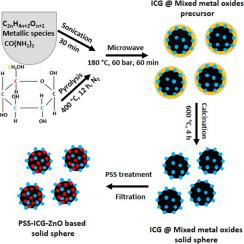Our official English website, www.x-mol.net, welcomes your
feedback! (Note: you will need to create a separate account there.)
PEG-assisted microwave hydrothermal growth of spherical mesoporous Zn-based mixed metal oxide nanocrystalline: Ester production application
Fuel ( IF 6.7 ) Pub Date : 2020-11-01 , DOI: 10.1016/j.fuel.2020.118489 Soroush Soltani , Nasrin Khanian , Thomas Shean Yaw Choong , Umer Rashid , Imededdine Arbi Nehdi , Mohsen Mohamed Alobre
Fuel ( IF 6.7 ) Pub Date : 2020-11-01 , DOI: 10.1016/j.fuel.2020.118489 Soroush Soltani , Nasrin Khanian , Thomas Shean Yaw Choong , Umer Rashid , Imededdine Arbi Nehdi , Mohsen Mohamed Alobre

|
Abstract In the present research, various spherical mesoporous ZnO-based nanocrystalline(ZnAl2O4, CuO-ZnO, TiO2-ZnO) were synthesized via post-calcination treatment at 600 °C for 4 h over N2 flow gas, which initially went through a simple PEG-assisted microwave hydrothermal route by adapting the varieties of PEG (i.e. PEG 2000, PEG 4000, PEG 6000, PEG 10000, and PEG 20000) using incomplete carbonized glucose (ICG) as a template. The as-synthesized mesoporous ZnO-basednanocrystallineswere further characterized by mean of XRD, N2 adsorption and desorption, NH3-TPD, FESEM, and EDX. The experimental outcomes revealed that the extent of PEG 6000 in mixture played the vital role in the growth of spherical mesoporous ZnO-based nanocrystallines compared to other PEG molecular weights. The N2 adsorption and desorption data confirmed the mesopore structure of the samples, possessing the specific surface areas in the range of 450.35–592.55 m2g−1. By verifying the optimum PEG-assisted microwave hydrothermal conditions, one-pot polymerization of poly(sodium4-styrenesulfonate) was employed to activate surface areas and mesopore walls by -SO3H functional groups using for ester productionthrough transesterification of used cooking oil, resulted in methyl ester content of 97.4% and excellent reusability for ten sequential reactions withoutanyfurtherregeneration. Moreover, biodiesel quality evaluation analysis showed that the prepared methyl ester satisfied both EN (14214) and ASTM (D6751) specifications.
中文翻译:

球形介孔锌基混合金属氧化物纳米晶的PEG辅助微波水热生长:酯生产应用
摘要 在目前的研究中,通过在 N2 气流中在 600 °C 下煅烧 4 h,最初通过简单的 PEG 合成了各种球形介孔 ZnO 基纳米晶(ZnAl2O4、CuO-ZnO、TiO2-ZnO)。使用不完全碳化葡萄糖 (ICG) 作为模板,通过调整各种 PEG(即 PEG 2000、PEG 4000、PEG 6000、PEG 10000 和 PEG 20000)的辅助微波水热途径。通过 XRD、N2 吸附和解吸、NH3-TPD、FESEM 和 EDX 进一步表征合成的介孔 ZnO 基纳米晶体。实验结果表明,与其他 PEG 分子量相比,混合物中 PEG 6000 的含量在球形介孔 ZnO 基纳米晶体的生长中起着至关重要的作用。N2 吸附和解吸数据证实了样品的中孔结构,比表面积在 450.35–592.55 m2g-1 范围内。通过验证最佳PEG辅助微波水热条件,采用聚(4-苯乙烯磺酸钠)的一锅聚合通过-SO3H官能团活化表面积和中孔壁,用于通过酯交换用过的食用油生产酯,得到甲酯97.4% 的含量和十个连续反应的优异重复使用性,无需进一步再生。此外,生物柴油质量评估分析表明,制备的甲酯满足 EN (14214) 和 ASTM (D6751) 规范。通过验证最佳PEG辅助微波水热条件,采用聚(4-苯乙烯磺酸钠)的一锅聚合通过-SO3H官能团活化表面积和中孔壁,用于通过酯交换用过的食用油生产酯,得到甲酯97.4% 的含量和十个连续反应的优异重复使用性,无需进一步再生。此外,生物柴油质量评估分析表明,制备的甲酯满足 EN (14214) 和 ASTM (D6751) 规范。通过验证最佳PEG辅助微波水热条件,采用聚(4-苯乙烯磺酸钠)的一锅聚合通过-SO3H官能团活化表面积和中孔壁,用于通过使用食用油的酯交换生产酯,得到甲酯97.4% 的含量和十个连续反应的优异重复使用性,无需进一步再生。此外,生物柴油质量评估分析表明,制备的甲酯满足 EN (14214) 和 ASTM (D6751) 规范。4%,十个连续反应的重复使用性极佳,无需进一步再生。此外,生物柴油质量评估分析表明,制备的甲酯满足 EN (14214) 和 ASTM (D6751) 规范。4%,十个连续反应的重复使用性极佳,无需进一步再生。此外,生物柴油质量评估分析表明,制备的甲酯满足 EN (14214) 和 ASTM (D6751) 规范。
更新日期:2020-11-01
中文翻译:

球形介孔锌基混合金属氧化物纳米晶的PEG辅助微波水热生长:酯生产应用
摘要 在目前的研究中,通过在 N2 气流中在 600 °C 下煅烧 4 h,最初通过简单的 PEG 合成了各种球形介孔 ZnO 基纳米晶(ZnAl2O4、CuO-ZnO、TiO2-ZnO)。使用不完全碳化葡萄糖 (ICG) 作为模板,通过调整各种 PEG(即 PEG 2000、PEG 4000、PEG 6000、PEG 10000 和 PEG 20000)的辅助微波水热途径。通过 XRD、N2 吸附和解吸、NH3-TPD、FESEM 和 EDX 进一步表征合成的介孔 ZnO 基纳米晶体。实验结果表明,与其他 PEG 分子量相比,混合物中 PEG 6000 的含量在球形介孔 ZnO 基纳米晶体的生长中起着至关重要的作用。N2 吸附和解吸数据证实了样品的中孔结构,比表面积在 450.35–592.55 m2g-1 范围内。通过验证最佳PEG辅助微波水热条件,采用聚(4-苯乙烯磺酸钠)的一锅聚合通过-SO3H官能团活化表面积和中孔壁,用于通过酯交换用过的食用油生产酯,得到甲酯97.4% 的含量和十个连续反应的优异重复使用性,无需进一步再生。此外,生物柴油质量评估分析表明,制备的甲酯满足 EN (14214) 和 ASTM (D6751) 规范。通过验证最佳PEG辅助微波水热条件,采用聚(4-苯乙烯磺酸钠)的一锅聚合通过-SO3H官能团活化表面积和中孔壁,用于通过酯交换用过的食用油生产酯,得到甲酯97.4% 的含量和十个连续反应的优异重复使用性,无需进一步再生。此外,生物柴油质量评估分析表明,制备的甲酯满足 EN (14214) 和 ASTM (D6751) 规范。通过验证最佳PEG辅助微波水热条件,采用聚(4-苯乙烯磺酸钠)的一锅聚合通过-SO3H官能团活化表面积和中孔壁,用于通过使用食用油的酯交换生产酯,得到甲酯97.4% 的含量和十个连续反应的优异重复使用性,无需进一步再生。此外,生物柴油质量评估分析表明,制备的甲酯满足 EN (14214) 和 ASTM (D6751) 规范。4%,十个连续反应的重复使用性极佳,无需进一步再生。此外,生物柴油质量评估分析表明,制备的甲酯满足 EN (14214) 和 ASTM (D6751) 规范。4%,十个连续反应的重复使用性极佳,无需进一步再生。此外,生物柴油质量评估分析表明,制备的甲酯满足 EN (14214) 和 ASTM (D6751) 规范。











































 京公网安备 11010802027423号
京公网安备 11010802027423号